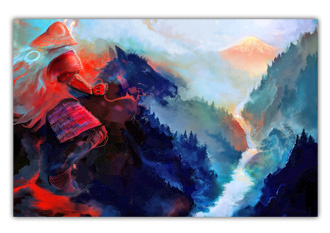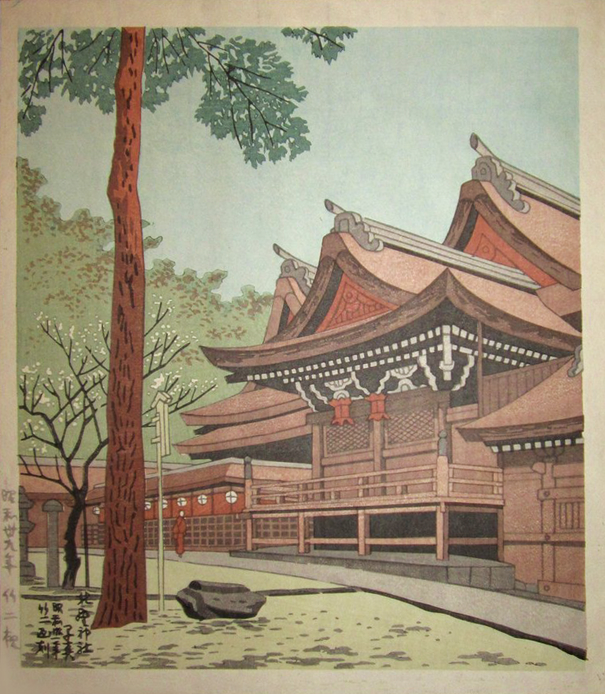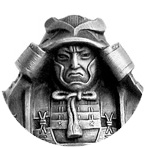The way of gods
shinto
-

It is human nature to try and make sense of the world by creating a system within which we, and everything surrounding us, logically fits into. Shinto, the first Japanese religion, may initially seem simple and naïve like many other archaic faiths. But actually, its wisdom is extremely profound. The essence of Shinto is that gods reside in everything and everything is gods. This can be interpreted in many ways; the belief that the Universe was chaotic, mystical, and that all within it was strongly connected existed in many primitive cults.
On the other hand, separation from the environment is a feature of recent civilization whose religions are based on codified strict moral dogmas, hierarchies, and symbols, thus also making human consciousness more orderly and logical. Modern religions are so comprehensive and awe-inspiring that they capture weak minds and entice them into worshiping their altar of Authority. Their promise of otherworldly personal salvation offers solace for desolate and tired souls. While religions do humanize people, their representatives are often charlatans who preach from books that are simply sets of rules that have nothing to do with true spirituality.
But Shinto doesn’t contain these elements; there are no clear-cut doctrines, sacred books, or laws. In fact, the Way of The Gods does not need them for it is based on the notion of inherent unity among all things. According to the Japanese, nature doesn’t require any interpretation. Likewise, humans don’t need any kind of moral evaluation. Both are simply part of the infinite and constantly changing world. In Shinto, Nature is absolute, perfect, and wise. It is the only permanent reality which our entire inner life reflects.
“Even in the form of cruel elements it was never viewed negatively as a force hostile towards humans, as something conflicting with goodness and beauty. The feeling of integrity of humans with nature, which had developed already in the framework of ancient Shintoism, formed the basis for their particular self-awareness, for the possibility of free contact with trees and grass, cliffs and mountains, animals, birds, and flowers. Everything in the world appears equally animate and conscious: a blade of grass, a waterfall, a rice spike and an island in the ocean. That was also valid for everything created by humans, be it a pottery vessel or a song. The existing and nascent was considered animate already by virtue of their belonging to the world and Nature, as part of the great Universe.”

Shinto Shrine by Asano Takeji (1964)According to Shinto, the Japanese world is perfect and eternal. It has neither beginning nor end; everything that is, was and will be is the result of its self-development and eternal change. This world follows its inner laws and nothing within it disappears without a trace or is left behind. In the Shintoist belief system there is no distinction between living and nonliving; everything is equally alive: humans, animals, plants, objects, spirits, and gods. This being the case, the Shintoists hold that in all natural phenomena, including humans, there lives a “god” or “spirit” called kami in Japanese. Kami are integrated with humans, and the world is nothing but a perpetual myriad of spirits, as real as we are. As the old saying goes, a son standing in front of a Shinto shrine was speaking to his dead father as if he, like all his other ancestors, were alive and sitting next to him. It is believed that their spirits determine both our individual fates and that of the entire world. That is why Shinto maintains that the goal of human life is to live in harmony with oneself and the world and to fulfill the precepts of the divine Ancestors who created it.
Shinto withholds from moral judgements and views things simply. What benefits people is good, but the reverse isn’t bad either. According to Shinto, bad things are only those which could destroy the world we inherited from the Ancestors. In fact, the concepts of “sin” and “morality” are so vague that they can be left to individual interpretation. The simple principle of Shinto is this: avoid doing things you would not like to be done to you and treat everything with care. Generally speaking, all primitive societies shared the ideal that people should act according to their natural needs. Thus, hunters expressed regret when killing their game and apologized by saying, “My family needs food.” They would never kill for fun.
The vital force and optimism intrinsic to Shinto made it a permanent and stabilizing element of Japanese society that did not recede into background even up to today. Additionally, Shinto was the mythological foundation of the ancient Japanese state, and its gods were very similar to the Greek gods of Olympus: they assumed human form, and their lives and motivations did not differ much from those of mortals. Some tales of the lives of Shinto gods may seem ironic or even humorous for modern readers. For example, when Susanoo, the god of storms and the sea, was unable to defeat a dragon, he resorted to trickery. He drank sake with it and engaged it in small talk until the beast got drunk, fell asleep, and he killed it. His prize was a beautiful girl. It sounds similar to the legend of Perseus and Andromeda, only less heroic. Shinto gods are more amorphous and numerous than their Greek counterparts. In fact, Shinto gods are innumerable since any human, even a stone, can easily be a god. Another difference is that a Hellene, while acknowledging the inevitability of fate, had more freedom of will. Greek myths tell many stories of conflicts between heroes and gods, and gods sometimes lose. In Shinto, especially after the introduction of Buddhism in Japan, the belief in destiny was resounding and insurmountable.
Back then people had a more mystical perspective and considered religion universal and necessary. Today’s civilization based on science, education, and commerce has created the illusion of a safe and rational world which has replaced earlier notions of human vulnerability and the fragile, mysterious meaning of life. In antiquity people had just started exploring their environment and depended heavily on the nature. They were weakened by wars, famines, and plagues; death was constantly staring them in the face. This made people reflect and philosophize on life. The ancient Japanese did not make a distinction between the world of spirits and the world of humans; between the dead and the living. If someone killed an enemy, their biggest fear was that his spirit might get revenge after death both in this life and the next. Overall, the unexplainable was the basis for mystical superstitions, rites, and faith in magic, which were abundant in Shinto.
Mythology woven with real life had shaped the customs, morals, and traditions of ancient Japan. It was an isolated, marginal world, which is why Shinto’s ideas of distinctiveness and of Japan’s special path symbolized by the emperor, a direct descendant and embodiment of the supreme gods, were so appealing. Emperor worship may be traced back to the cults of the chieftains who... read further in the bookBack to the Blog
This is part of a chapter from Samurai: Ascension by A. R. Berg

